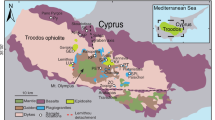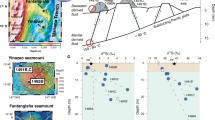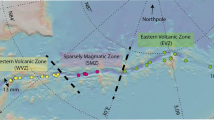Abstract
CHLORIDE is the dominant anion in submarine hydrothermal fluids and plays a fundamental part in controlling their chemistry1. The endmember Cl concentrations in virtually all submarine hot springs deviate from ambient sea water (∼541 mmol kg–1) and range from 188 mmol kg–1 at the ASHES vents on Axial Volcano2 to 1,090 mmol kg–1 at the Southern Juan de Fuca Ridge3. A variety of mechanisms have been proposed to explain these Cl enrichments and depletions including: rock hydration and dehydration4, phase separation2–3,5–7, and the formation and dissolution of a retrograde soluble phase8. Support for the latter hypothesis came from hydrothermal fluid/basalt experiments which showed large changes in dissolved Cl at specific reaction conditions9 and also from the presence of Cl-rich minerals phases in ultramafic rocks10. We have carried out the first systematic study of Br and I in mid-ocean ridge hydrothermal vent fluids to constrain the models of halide diversity better by ascertaining their behaviour relative to Cl. The cohesiveness of the Br and Cl data and the similarity of Br/Cl to the seawater ratio suggests a single, non-fractionating process controls the salinity of sediment-starved mid-ocean ridge hydrothermal systems. The thermal decomposition of organic matter provides an additional source of Br and I in sediment-hosted systems.
This is a preview of subscription content, access via your institution
Access options
Subscribe to this journal
Receive 51 print issues and online access
$199.00 per year
only $3.90 per issue
Buy this article
- Purchase on Springer Link
- Instant access to full article PDF
Prices may be subject to local taxes which are calculated during checkout
Similar content being viewed by others
References
Bowers, T. S. et al. J. geophys. Res. 93, 4522–4536 (1988).
Massoth G. J. et al. Nature 340, 702–705 (1989).
Von Damm, K. L. & Bischoff, J. L. J. geophys. Res. 92, 11334–11346 (1987).
Von Damm, K. L. et al. Geochim. cosmochim. Acta 49, 2197–2220 (1985).
Bischoff, J. L. & Pitzer, K. S. Earth planet. Sci. Lett. 75, 327–338 (1985).
Von Damm, K. L. J. geophys. Res. 93, 4551–4561 (1988).
Kelly, D. S. & Delaney, J. R. Earth planet. Sci. Lett. 53–66 (1987).
Edmond, J. M. et al. Earth planet. Sci. Lett. 46, 1–18 (1979).
Seyfried, W. E. Jr Berndt, M. E., & Janecky, D. R. Geochim. cosmochim. Acta 50, 469–475 (1986).
Rucklidge, J. C. & Patterson, G. C. Contr. Miner. Petrol. 65, 39–44 (1977).
Campbell, A. C. et al. Nature 335, 514–519 (1988).
Campbell, A. C. et al. J. geophys. Res. 93, 4537–4549 (1988).
Campbell, A. C., Edmond, J. M., Colodner, D. & Palmer, M. R. Eos 68, 1531 (1987).
Campbell, A. C., German, C., Palmer, M. R. & Edmond, J. M. Eos 69, 1271 (1988).
Michard, G. et al. Earth planet. Sci. Lett. 67, 297–307 (1984).
Grimaud, D., Michard, A. & Michard G. C. r. hebd. Sèanc. Acad. Sci., Paris 299 (II), 865–870 (1984).
Unni, C. K., thesis, Univ. Rhode Island (1976).
Price, N. B. & Calvert, S. E. Geochim. cosmochim. Acta 41, 1769–1775 (1977).
Oswald, H. R. & Feitknecht, W. Helv. chim. Acta 47, 272–289 (1964).
Miura, Y., Rucklidge, J. & Nord, G. L. Contr. Miner. Petrol. 76, 17–23 (1981).
Wicks F. J. & Plant, A. G. Can. Mineralogist 17, 785–830 (1979).
Rehtijarvi, P. Econ. Geol 79, 549–552 (1984).
Prichard, H. M. & Cann, J. R. Contr. Miner. Petrol. 79, 46–55 (1982).
Ito, E. & Anderson, A. T. Contr. Miner. Petrol. 82, 371–388 (1983).
Vanko, D. A. Am. Mineral. 71, 51–59 (1986).
Gregory, R. T., & Taylor, H. P. J. geophys. Res. 86, 2737–2755 (1981).
Cathles, L. M. Econ. Geol. Mon. 5, 439–487 (1983).
Shanks, W. C. & Seyfried, W. E. J. geophys. Res. 92, 11387–11399 (1987).
Bowers, T. S. J. geophys. Res. 94, 5775–5786 (1989).
Morris, A. W. & Riley, J. P. Deep-Sea Res. 3, 699 (1966).
Wang, Y. C. & Gieskes, J. M. Eos 69, 1263 (1988).
Author information
Authors and Affiliations
Rights and permissions
About this article
Cite this article
Campbell, A., Edmond, J. Halide systematics of submarine hydrothermal vents. Nature 342, 168–170 (1989). https://doi.org/10.1038/342168a0
Received:
Accepted:
Issue Date:
DOI: https://doi.org/10.1038/342168a0
This article is cited by
-
Halogens and noble gases in Mathematician Ridge meta-gabbros, NE Pacific: implications for oceanic hydrothermal root zones and global volatile cycles
Contributions to Mineralogy and Petrology (2015)
-
Geochemical anomalies of hydrothermal plume at EPR 13°N
Science in China Series D: Earth Sciences (2007)
-
Rebirth of a sea-floor vent
Nature (1995)
-
Cl, Br and I analyses of metamorphic and sedimentary rocks by isotope dilution mass spectrometry
Contributions to Mineralogy and Petrology (1991)
Comments
By submitting a comment you agree to abide by our Terms and Community Guidelines. If you find something abusive or that does not comply with our terms or guidelines please flag it as inappropriate.



